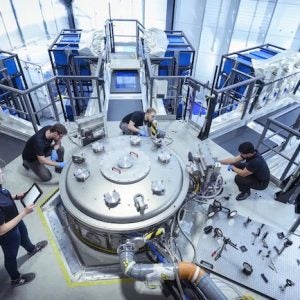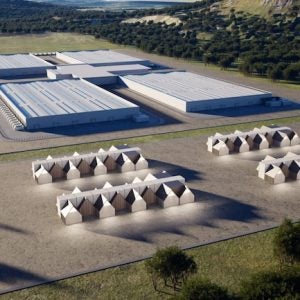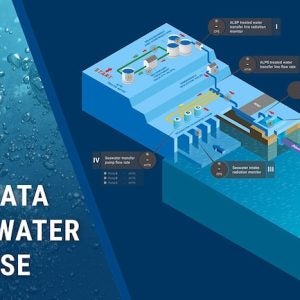
France’s Orano has established two working groups which bring together the designers in France advanced modular reactors (AMRs) based on innovative fast neutron reactors (FNRs) and fast neutron molten salt reactors (MSRs). Orano says the groups are open to all designers of these types of reactors who wish to join.
“Some AMRs are notable for their ability to use fuel based on recycled plutonium, such as MOX (mixed oxide fuel) or molten salt fuels,” Orano noted. “These features make for reactors which are potentially well-suited to long-term, sustainable use of resources and the reduction of nuclear waste. Orano, historically active in the fuel cycle of conventional reactors, is also interested in these advanced reactor designs.”
By establishing these working groups, Orano is acting as a strategic partner for start-ups working on the development of AMRs. Orano has signed two collaboration charters, setting up two “sharing groups” which will make it possible to pool the need of start-ups relating to the development of fuels.
The first FNR MOX sharing group brings together Orano, Hexana, newcleo and Otrera. Its aim is to work on the developments necessary for the production of the MOX fuel used in these reactors and its future processing in a facility on Orano’s La Hague site, as well as on the associated logistical solutions.
The second MSR sharing group brings together Orano, Naarea, Stellaria and Thorizon. Its aim is to work on the developments necessary for the production of the liquid fuel used in these reactors, as well as on the associated logistical solutions and the prospects of processing these salts on Orano’s La Hague site.
These collaborations follow the France 2030 investment plan, which aims to promote the emergence of high-end nuclear technologies and reinforce France’s position as a leader in energy innovation. They will complement existing collaborations with the two start-ups, Stellaria and Thorizon, established following the call for projects for phase 1, which ran until June 2023.
AMRs, which can complement high-power reactors, are intended to offer solutions in the realms of:
- Decarbonisation: AMRs could supply heat to industrial sites or urban heating networks, or produce hydrogen without creating any CO2 emissions.
- Recovering resources: fast neutron AMR reactors should allow optimised recycling of used fissile materials, which will reduce the quantity of nuclear waste over the long term.
Orano says it is interested in the concept of reactors which can run not only on the plutonium from used fuel from existing reactors but also on minor actinides, which until now have been treated as vitrified waste. By coupling this technology with the recycling of uranium and plutonium in light water reactors which are already used in several countries, in particular thanks to the processing of used fuel at facilities such as Orano’s La Hague site, the Orano group could go even further in terms of the recovery of nuclear materials and reduction of waste.
The France 2030 re-industrialisation plan was launched by President Emmanuel Macron in October 2021 with funding of €54bn ($58bn) to support schemes to be deployed over five years. The plan has 10 objectives, the first of which is by 2030, to develop small, innovative nuclear reactors in France with better waste management.
This was followed in March 2022 by a Call for Proposals by Bpifrance for Innovative Nuclear Reactors with funding of €500m. Eight designs were selected in 2023, including those proposed by Naarea, newcleo, Hexana and Otrera. Naarea and Newcleo shared a €25m grant. The other six shared €77.2m in funding, plus €18.9m in technical support from France’s Atomic Energy Commission (CEA – Commissariat à l’énergie Atomique et aux énergies Alternatives). In March 2024, Thorizon and Stellaria, both already in consortium with Orano, were selected by the French government to receive funding through the France 2030 national investment plan.
Of the six start-ups selected to participate in Orano’s working groups, three were spun out of CEA – Hexana, Stellaria and Naarea. Thorizon was spun out of NRG, which operates the High Flux Reactor at Petten in the Netherlands. In February 2024, Thorizon signed a strategic partnership agreement with Naarea to advance the development of molten salt reactors in Europe. The previous month, Naarea signed a similar strategic partnership with newcleo.
The companies in Orano’s first working group – Hexana, newcleo and Otrera – are all developing fast neutron reactors of different designs.
Hexana is looking to design a sodium-cooled fast neutron reactor type, incorporating a high temperature storage device. It comprises two small 400 MWt reactor units supplying a heat storage device. It will be able to cater for the variations in electrical power required by manufacturers. An adjoining conversion system will allow it to generate electricity if necessary and flexibly to compete with gas power plants. It will also be able to directly supply heat to energy-consuming industries.
Newcleo is developing a lead-cooled fast neutron mini-reactor (30MWe then 200MWe) and says its reactor design “has been optimised over the last 20 years leading to the concept of an ultra-compact and transportable 200 MWe module with improvements in energy density compared to other technologies”.
Otrera Nuclear Energy (ONE), founded in February 2023 is proposing a sodium-cooled fast-neutron reactor capable of high-efficiency cogeneration (110 MWe, 185 MWt).
The companies in Orano’s second working group – Naarea, Stellaria and Thorizon – are developing MSRs with a range of characteristics.
Naarea (Nuclear Abundant Affordable Resourceful Energy for All) Naarea, founded in 2020, is developing the XAMR molten salt fast neutron micro-generator (40MWe or 80MWt). According to Naarea’s website, the company has an ambitious development plan organised into three phases, conducted in parallel. These include: the finalisation of a digital twin in 2023; submitting the safety options dossier (DOS) for commissioning of a prototype by 2028; and launching mass production by 2030. As yet, no completed digital twin has been announced.
Stellaria aims to develop an energy system based on a chloride molten salt reactor. This technology integrates the fuel in liquid form, dissolved in molten salts which also constitutes the coolant. Liquid fuel can remain almost continuously in the reactor core. Its main advantages are in the combination of energy production and multi-recycling of fuel with a high level of passive safety by design. The reactor proposed by Stellaria will be very compact measuring 4 cubic metres and will produce 250 MWt. It will be able to use a diversified range of nuclear fuels including uranium, plutonium, MOX, minor actinides, and even thorium.
Dutch company Thorizon is developing a 250 MWt/100 MWe ‘thorium molten salt reactor’ that will use long-lived waste in combination with thorium as fuel. Thorizon aims to construct a pilot reactor system before 2035. This will provide 250 MWt of industrial heat, which can be directly used in industrial processes for the chemical industry or hydrogen production. Alternatively, it can produce 100 MWe to provide electricity. The molten salt fuel adopted by Thorizon uses a combination of long-lived elements from reprocessed used fuel and thorium. The reactor will be able to recycle long-lived waste from existing nuclear facilities. The core is composed of a set of cartridges that is replaced every 5-10 years.






